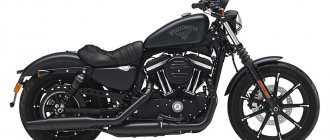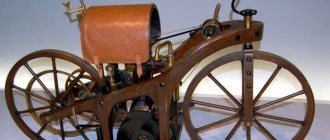The scooter is a fairly common vehicle today; it does not require a lot of fuel, but at the same time it does not provide the incredible speeds that its two-wheeled motorcycle brothers can boast. This is a rather specific type of transport that not everyone will choose for themselves. But all the people who like scooters are always excited about riding them, they have a lot of fun and also find them extremely practical. But at the same time, not a single vehicle is insured against breakdowns, including a scooter.
Malfunctions can be very diverse, but in this article we will talk about electronics, and more precisely, about how to check the switch on a scooter. Naturally, if you have no idea what we are talking about, then you should not immediately take up the tools. It is better for you to calmly and carefully study exactly how the electronics in a scooter work, how checking the switch on a car and on a moped differs, and also what exactly you can do to check the electronics for damage and repair your vehicle. In general, before considering the question of how to check the switch on a scooter, you should understand what it actually is.
Switch for moped
Moped owners will be very interested in learning how to properly install the switch on your moped.
Switch
- this is a device that is responsible for supplying high voltage pulses to the spark plug. This device works in tandem with an ignition coil.
First, let's look at what types of moped switches there are. There are not many of them, only three:
- Switch with built-in high voltage generator (DC CDI)
- A switch that needs a high voltage source (AC CDI)
- Coil-commutator
Let's look at each briefly.
DC switch
Due to its ease of connection, this is one of the most common moped switches. The most basic model has only 4 contacts:
- Ignition coil
- Hall Sensor
- Plus(12V);
- Minus
Switches of this type exist in various modifications:
- with max. limiter rpm
- without limiter
- with additional contacts
- with changing ignition timing
AC switch
This type of moped switch works great without 12V DC. Despite its simpler design, it has a slightly more complicated connection to the moped's electrical circuit. This type of switch, due to its small size, exists without a max. limiter. rpm, and can also work in conditions under which the DC switch is inoperable. That is, by removing the battery, the ignition switch, and the relay-regulator, the moped with the AC switch will start and drive.
Ignition circuit components
The ignition circuit is an important part of the scooter's electrical system, without which it simply will not work without proper assembly. The circuit includes a coil, a spark plug, a switch, a generator, and a CDI ignition module. The latter looks like a small block, on one side it is plastic, on the other it is filled with compound. It is for this reason that when a unit fails, it is completely replaced without trying to disassemble it.
The CDI module has outputs for connecting five conductors. It is usually located quite close to the battery, can be mounted on the scooter frame or have a special cell. Most often, the CDI unit is located closer to the bottom of the vehicle, so it is not easy to reach. Without this element the system will not work.
Relay regulator
The relay regulator is colloquially called a stabilizer. This element is needed in order to rectify the voltage and stabilize it to the required level, which is suitable for the operation of the scooter’s electrical appliances. In Chinese and many Japanese models you need to look for it in the front of the vehicle, usually under the fairing. During operation, the radiator of the part becomes very hot, so it is placed where it can receive air cooling.
During operation, the generator produces alternating current, which is supplied first to the relay-regulator, and then moves on. The relay converts alternating voltage to direct voltage, in addition, it stabilizes the voltage to 13.5-14.8 Volts. If the voltage is less, the battery will not be able to charge; if it is more, there is a high risk of failure of the electrical system.
The regulator usually has 4 wires. They differ in color; in a standard diagram, the green wire is always ground. Red is under constant voltage. White supplies the regulator relay with the voltage supplied by the generator: this is alternating current. The yellow wire also goes from the generator to the relay regulator. The relay converts the voltage, turning it into a pulsating one. After this, the voltage goes to lighting fixtures, which are the most powerful consumers. Some models have an illuminated dashboard, additional lighting, running lights or other types of suspension. All this is powered by the same wire.
It is impossible to stabilize the voltage that powers the lamps. It can only be limited using a relay regulator to a level of 12 V. Even when operating at low speeds, the generator produces an excessively high voltage, which is not suitable for operating lamps and other lighting devices. If the relay-regulator is faulty, the dimensions or lamps that will be turned on at that moment may burn out.
However, the device itself is not particularly complex. If you disassemble it, inside you can find a printed circuit board, an electronic circuit with a BT151-650R thyristor, a diode bridge for which 1N4007 diodes are used, one powerful 1N5408 diode, in addition, there are wiring elements that include the following: low-power SMD transistors, capacitors electrolytic, zener diode and various resistors. It is this simplicity that leads to the fact that the relay often cannot withstand heavy loads and breaks. Therefore, it doesn’t hurt to have a spare one and carry it with you: it changes quickly.
Alfa moped switch
In this part of the article, we will look at the pinout feature of the switch for the Alpha moped (and, to boot, the Delta), and also find out the purpose of each wire. All information is presented in the diagram below.
It is noteworthy that the same switches can be installed on mopeds of various brands of Chinese production, since there are a lot of Alpha clones.
As we can see, the pinout of this switch is very simple.
Pinout
- Black and yellow wire 1
goes to the ignition coil. - Black-red wire 2
is responsible for power. - Contact 3
is missing in principle. - Black and white wire 4
is responsible for turning off the engine and goes to the ignition switch. - Blue-white pin 5
goes to the Hall sensor. - The last, green pin 6
is ground.
what to do if the brain (switch) of a motorcycle burns out / Blog named after. gorini4 / BikePost
Hello, Baykpostovchanin. It seems you are using AdBlock. BikePost develops and exists due to advertising revenues. Add us to the exceptions.
open letter how to disable
Mileage
votes: 78
Blog named after gorini4
Denis
3743rd place in the rating of bikeposts and so many people have such a situation that the motorcycle loses a spark somewhere or the spark disappears on one ignition coil. After a full examination, it turns out that the brains (switch) are dead, and since for some motorcycles the brains are extremely expensive I set out to try to restore those same burnt brains. Let me explain: a common cause of brain death is: 1. Overcharging of the generator. 2. Accidentally lost contact at the battery terminals while the engine is running. (ALWAYS CHECK THE BATTERY TERMINALS FOR THE PRESENCE OF OXIDES AND FOR TIGHTENING OF THE TERMINALS!!! Because this little thing can cost the life of the brains of your motorcycle) More often, and especially in motorcycles since 1990, protection against overvoltage or internal short circuit began to appear in switches (they especially like short-circuit the capacitors) and when this protection is triggered, everyone thinks that the switch has suddenly died and simply throws it away, replacing it with a new one. the brain can be easily restored if everything in it burns out except the processor. (if the processor burns out, you just can’t buy it anywhere as a part) if anyone needs help with repairing the brains of the moto, please contact me, I’ll help as much as I can, I’m not attaching photos of the repaired brains because I simply don’t have these photos.
There is also a case when the brains of a motorcycle can be completely replaced with homemade ones (I personally did it myself), this is especially true for motorcycles of the 80s when original brains are very difficult to find, and if you do find them, they will be very expensive.
bikepost.ru
Scooter switch pinout
The scooter switch pinout is a diagram of its connection to the scooter's electrical circuit. There are several types of devices: for example, in Chinese models a DC or AC type switch can be used. They differ from each other not only visually, but also in the principle of energy accumulation for further creation of a spark. DC takes energy directly from the battery, while AC is tied to the generator coil.
Simulation stand
If you do not have a second scooter, and also do not have access to it, then you should think about purchasing or making a special stand for yourself that would simulate the operation of your scooter. It is ideal for testing the switch on a Honda scooter, as well as on any other model, and if you regularly use such a vehicle, then the likelihood is that you will have to use the stand more than once or twice, so it is definitely worth the investment into it.
Now it is much more convenient to purchase it and install it in your garage, so that, if necessary, you can always check any part without using another scooter. But you can also do it yourself - only in this case you need to have very high skills and abilities in engineering, and it is also advisable to have impressive experience with such equipment. You should also know that such a stand has other advantages over a second scooter for control.
Pinout
If you have a 4T motor installed on your scooter, the pinout of the switch will depend on what type the scooter requires. For DC it will be as follows:
- The leftmost terminal on top should connect to the generator sensor.
- Ground is connected to the terminal located under it. You can tie the negative wire, for example, to the body of a moped; it is important that the part is metal.
- The upper terminal, located in the center, is connected to the wire leading to the ignition coil drive.
- The one located under it is also connected to the negative wire (ground).
- The wire from the ignition switch is connected to the upper rightmost terminal, which is needed to turn off the engine.
- The power wire is connected to the terminal located under it; it also comes from the ignition switch.
If you have an AC type, the location of the terminals is the same, but they are connected differently:
- We move from left to right, first the top row, then the bottom.
- Here the wire from the generator sensor goes, as in the previous version.
- Next comes the ignition coil wire.
- And at the end there is a “silencer” for the ignition switch.
- The first two terminals are the negative wire, “ground”.
- To the last remaining terminal we connect the power wire from the high-voltage winding of the generator. This point is the main difference when connecting an AC switch from a DC one.
Scooter Honda Dio AF 18 27
The Honda Dio AF 18 has a slightly different switch, made in Japan, which is why the pinout of the scooter is a little unique, and the mounts on the switch are different. It is connected as follows: from left to right, first the upper, then the lower terminals. Location:
- Hall Sensor.
- Ignition coil.
- Weight.
- Ignition lock.
- Power wire from a high voltage coil.
Yamaha Jog Scooter
Several types of generator can be installed on this type of motor vehicle. The most common option has 5 contacts, with wires already coming out of it. Therefore, if you have original wiring, you need to connect as follows:
- Orange should lead to the ignition coil and alternator.
- Black - to the ignition switch.
- Purple – Hall sensor.
- The remaining two wires are connected to the ignition coil.
Features of the work
Before starting assembly, it would be a good idea to take a smartphone or digital camera with you to familiarize yourself with the correct pinout diagram. You can also go to specialized Internet resources and find official images showing the connection diagram of the electronic filling. Don't forget to take a full set of electrical tools that may be needed to complete the replacement.
Having found the switch, you need to clarify its type. To do this, just connect the multimeter to the power cable, turn on the ignition and look at the display readings. We will have a DC type only if power appears.
It also happens that food does not appear. In this case, you need to select the AC test mode, selecting a range of 200 volts. Crank the power unit using the starter. In the case of AC type switches, power will appear immediately.
Why is it important to determine the switch type?
Some owners of scooters (in particular, those from Yamaha) often face the problem of correct identification. There are practically no official manuals, so owners have to work blindly and trust in luck. Buying a switch that is not designed to be used on a scooter can have serious consequences. The first of these is the immediate failure of the part being replaced. There is no difference in what kind of switches are installed - DC on a scooter that only supports AC, and vice versa. The electronic filling will burn out instantly. In some cases, there was a failure of a number of other related electronic elements - light bulbs, mini-radio tape recorders, alarms, and so on. Without knowing which switch is installed on the scooter, owners are guaranteed to lose good money.
Before connecting a new switch to a scooter, it would be a good idea to first read the official manuals. In some cases, manufacturers provide information about installed switches on four-stroke scooters.
You can make the connection according to a special scheme, or you can do the work yourself, having previously photographed all the connector connection points. Attentiveness and slowness are the main factors determining the success of the work performed.
DC CDI switch
One of the most famous switches due to the ease of connection. The most common one has only 4 contacts for the following wires:
Despite its simplicity, there are many switches of this type. It is available with and without a maximum speed limiter, with variable ignition timing, and with additional contacts for a wide variety of needs. In particular, you can “hook” a side stand to some switches, so that when opened, the engine will not spin up to the speed at which the clutch engages. This is done in order to insure the driver against dangerous rash actions.
Stock switch for scooter
A stock or original switch is the one that is installed on the vehicle from the factory. Its main advantage over others is that it is already designed for the equipment with which it operates; it is often equipped with a limiter so that the engine does not develop speeds that are dangerous to the life and life of the main bearings, the entire crank mechanism, cylinder-piston groups and other structures and assemblies. The stock commutator is the main source of a well thought out engine's longevity, efficiency and durability. Those who take the risk of replacing a factory switch with a sports (tuning) one are risking a lot. Those who do not fully understand what they intend to do risk even more. Inept installation of such parts and their subsequent use with a conventional engine often lead to a decrease in service life and the death of the engine, sometimes on the same day.











